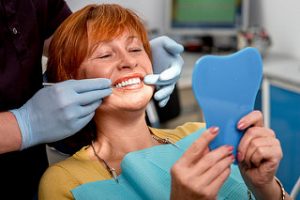CHOOSE AND COMMIT – STEP 3
August 27, 2018
 In the first segment of this series I discussed the role of caregivers in early dental care. Prevention starts as early as 6 months into pregnancy and continues with essential steps early in a child’s life. The second segment discussed dental care for children as they develop. In this final segment I will discuss easy prevention and maintenance steps to take to help ensure dental health for a lifetime.
In the first segment of this series I discussed the role of caregivers in early dental care. Prevention starts as early as 6 months into pregnancy and continues with essential steps early in a child’s life. The second segment discussed dental care for children as they develop. In this final segment I will discuss easy prevention and maintenance steps to take to help ensure dental health for a lifetime.
As I stated a few weeks ago, in preventive-based dental practices we go far beyond saying to patients, “you need to brush and floss more.” We truly believe that dental disease, both dental caries (cavities) and gum disease, is very preventable. However, we recognize that not every individual is equal when it comes to susceptibility. Each person presents with their own unique genetic pool, good and bad habits, number and position of teeth, and willingness to truly make a change. The one constant is that most of us have room for improvement.
Here are 4 simple things that will help maintain dental health for a lifetime:
Professional Maintenance – It is easy to put professional hygiene visits on the backburner. We are pulled in many different directions in life, and the absence of pain in our mouths sometimes grants us permission to skip regular dental appointments. Some people will use the excuse of lack of insurance for not going on a regular basis. The most important thing you can do to prevent dental disease is to commit to a lifetime of professional dental visits. This is a choice. Your cell phone costs more per year than these visits will. Some people require four visits a year to maintain health and others may only require one. There are no set rules. However, it is up to you to make the commitment.
Home Care – Most people have significant room for improvement with their home care. Coaching, in anything, increases an individual’s potential for improvement. Think of us as your dental coach. We routinely ask patients to bring their toothbrushes with them to their appointments to review technique. As simple as it sounds, constant evaluation and improvement of your home care can only decrease your chances of dental disease.
Diet – What we put in our mouths, when we do it and how often are all choices as well. As with everything, some people can get away with things that others cannot. Decay rates are different for different people and can change during the course of a lifetime. This is an important topic to routinely discuss at regular visits.
Oral Appliances – This is in reference to any oral appliance typically worn while sleeping. This is another situation where absence of any symptoms sometimes allows us to ignore what is really going on. It is easy to get someone to wear an appliance in their mouth if they present with TMJ issues or headaches. On the other hand, it is often difficult to convince someone to routinely wear a nighttime appliance if they have no symptoms. For example, people who have had braces should be wearing retainers. People who have sleep apnea may have the option of wearing an oral appliance. However, those who have evidence of clenching and/or grinding are the most undertreated. It is my firm belief that if more people committed to unfailing routine use of a properly made nighttime appliance, many potential dental problems could be avoided.
I believe that most dental disease is preventable. What it takes to prevent dental disease in one person may very well not be the same for another. Choose and commit to these four things and you are guaranteed fewer dental problems over your lifetime.
Dr. St. Clair maintains a private dental practice in Rowley and Newburyport dedicated to health-centered family dentistry. If there are certain topics you would like to see written about or questions you have please email them to him at jpstclair@stclairdmd.com. You can view all previously written columns at www.jpeterstclairdentistry.com/blog.
THE NEXT STAGE – STEP 2
August 20, 2018
 Last week I talked about oral care for mothers-to-be and babies. Preventive care truly does start before birth. This week we journey past those early years of life.
Last week I talked about oral care for mothers-to-be and babies. Preventive care truly does start before birth. This week we journey past those early years of life.
In preventive-based dental practices we go far beyond saying to patients, “you need to brush and floss more.” We truly believe that dental disease, both dental caries (cavities) and gum disease, is very preventable. However, we recognize that not every individual is equal when it comes to susceptibility. Each person presents with their own unique genetic pool, good and bad habits, number and position of teeth, and willingness to truly make a change. The one constant is that most of us have room for improvement.
It goes without saying that preventive care includes regular visits to the dentist. Based on my experience, even many of those who visit the dentist on a regular basis have significant room for improvement. However, it is up to your caregivers, hygienists and dentists, to have that preventive frame of mind to go beyond just telling you to brush and floss more.
Technique is vital when it comes to home care. Although daily removal of plaque (the thin, sticky film of bacteria that creates cavities and gum disease) can be accomplished with a manual toothbrush, the proper power toothbrush is more appropriate and effective for most people. We routinely ask patients to bring their toothbrushes with them to their appointments to review technique. Think of your dentist and/or hygienist as your dental coach. Coaching, in anything, increases an individual’s potential for improvement.
The same approach goes for kids. Although we do the same thing with children, they need that additional coaching from home. The best way to guide your family to good oral health is to lead by example. Parents should supervise toothbrushing by children younger than age 8 to make sure they are doing a thorough job. This also goes for flossing. This is done until the child is consistently getting good homecare reports at dental visits.
The challenge of good home care increases with the addition of braces. Children and adults in braces need extra coaching on technique and more time spent on their daily routine. I am a firm believer that preventive visits to the dentist should increase during orthodontics. There is too much at risk during this time and the extra professional care and coaching are vital to escaping the pitfalls of poor homecare while braces are on.
As life goes on, your genetic make-up, the amount of professional care and coaching you receive, your effectiveness at home, and your willingness and ability to improve, will shape your oral health. The fact of the matter is, there are those who need more professional care and more rigorous homecare than others.
As I stated earlier, I believe that most dental disease is preventable. What it takes to prevent dental disease in one person may very well not be the same for another. Between finding the right fit with a dental office, utilizing the coaching expertise of those individuals, using the right homecare products, and always striving to improve, excellent oral health for a lifetime is possible.
In the final segment of this series next week I will discuss some simple ideas to maintain good dental health for your entire adult life. It is simpler than you think.
Dr. St. Clair maintains a private dental practice in Rowley and Newburyport dedicated to health-centered family dentistry. If there are certain topics you would like to see written about or questions you have please email them to him at jpstclair@stclairdmd.com. You can view all previously written columns at www.jpeterstclairdentistry.com/blog.
STARTING AT BIRTH – STEP 1
August 16, 2018
 Research shows that babies are born without any harmful bacteria in their mouths. However, once bacteria colonize in the mouth, children are more prone to cavities in their baby teeth and permanent teeth. How do they get the bacteria? Caregivers.
Research shows that babies are born without any harmful bacteria in their mouths. However, once bacteria colonize in the mouth, children are more prone to cavities in their baby teeth and permanent teeth. How do they get the bacteria? Caregivers.
Most parents don’t know that they can pass harmful bacteria from their mouth to their baby’s mouth. The most critical time is during the child’s first 2 ½ years of life. Most children are born without a single tooth. Can bacteria passed to children without teeth affect their decay potential for their whole life? According to research the answer is yes.
Here’s a shocker…..If you have a history of poor oral health, including many fillings in your mouth, you are much more likely to transfer these harmful bacteria to children. How? Typically, this takes place through common parental or caregiver behaviors such as sharing utensils or cleaning a baby’s pacifier with your own saliva.
Prevention starts as early as 6 months into a pregnancy. Research shows that expectant mothers who chewed gum containing the sweetener xylitol are much less likely to have decay-causing bacteria in their saliva. So, take-home point number one, it is essential for expectant parents and caregivers to keep their own mouths healthy. If you reduce the bacterial levels in your own mouth, you are not only benefiting yourself but also that of your unborn child. Visiting a dentist regularly, even more often when you are pregnant, improving your homecare, and using products that specifically reduce bacteria are all essential.
Your baby is born; now what? First, eliminate potential ways of transferring saliva to your baby. Do not share utensils or let grandma or grandpa lick a cloth to clean around a baby’s mouth. Wiping your baby’s gums with a clean cloth after meals is also good practice to help reduce bacterial levels.
Once a child starts getting teeth, diet plays a significantly greater role. Minimizing snacks and drinks with fermentable sugars is key. This starts with the bottle. Bottle syndrome, also known as baby bottle tooth decay, occurs when teeth become exposed, at length and frequently, to liquids containing a form of sugar. All liquids that contain sugar can cause bottle syndrome, including breast and cow’s milk (which contain the sugar lactose), formula, fruit juice (which contains the sugar fructose), soda and other sweetened drinks. It is caused by the constant presence of milk, formula, or fruit juice in a child’s mouth during the night, during breastfeeding, during naps, or for extended periods during the day. The liquid pools around the teeth and gums, providing food for the bacteria in plaque. The bacteria produce acid as a byproduct when they consume the sugar. This acid attacks your child’s teeth and causes decay.
When your child feels comfortable with a toothbrush, brush their teeth and gums twice a day with an extra-soft toothbrush. Use a pea-sized amount of toothpaste without fluoride until your child is old enough to spit. If your child doesn’t like toothpaste, it’s fine to brush without it.
Prevention starts before babies are born. It starts with taking care of your own mouth.
Next week, in the second part of this 3-part series, we will explore some important issues to consider during the next phase of life.
Dr. St. Clair maintains a private dental practice in Rowley and Newburyport dedicated to health-centered family dentistry. If there are certain topics you would like to see written about or questions you have please email them to him at jpstclair@stclairdmd.com. You can view all previously written columns at www.jpeterstclairdentistry.com/blog.
INTRO TO SLEEP APNEA – PART 2
August 9, 2018
 Last week I discussed what sleep apnea is. This week I will discuss diagnosis and treatment.
Last week I discussed what sleep apnea is. This week I will discuss diagnosis and treatment.
Specialists who diagnose and treat sleep apnea express varying opinions about the cause and best treatment of the breathing disorder. Ask a lot of questions of each specialist to determine the most appropriate procedure or combination of procedures for your particular case. Here are the specialists who may be involved in diagnosing your sleep apnea and the ways they might assist you:
An ear, nose and throat doctor (ENT) may recommend surgery to clear blockages caused by a genetic abnormality in the nose or throat. The uvulopalatopharyngoplasty (UPPP) procedure eliminates tissue from the back portion of the mouth near the top of the throat. The adenoids and tonsils may be removed as well. Should your airflow blockage be life-threatening, the ENT may find it necessary to build an opening in the windpipe through a procedure called a tracheotomy. This would be an extreme case. Also, an operation on your nose might be necessary to improve a deviated septum or to remove polyps that are blocking your airflow.
A pulmonologist (a doctor who deals with diseases of the respiratory system) may recommend a sleep evaluation based on an analysis of your breathing muscle capacity. Pulmonologists may also recommend the use of oxygen should blood-oxygen levels fall to dangerous levels during sleep.
A neurologist (a doctor who deals with nervous system disorders) will evaluate brain functionality and may recommend a medication such as acetazolamide to improve the brain’s ability to trigger the breathing muscles.
A cardiologist (a doctor who deals with diseases and disorders of the heart) may recommend a sleep test as well.
A sleep specialist may perform a sleep test that measures oxygen blood level (among other anatomical factors) during sleep. Sleep specialists may recommend the use of a continuous positive airway pressure (CPAP) machine. The machine delivers a continuous flow of oxygen through a mask that you wear over your nose during sleep.
An alternative is a bi-level positive airway pressure (bi-level PAP) machine, which increases the oxygen level upon inhalation and decreases it upon exhalation. An adaptive servo-ventilation (ASV) machine is a third choice. This equipment measures your level of breathing and records the data so that oxygen delivery can be matched to your specific needs. A CPAP machine is usually considered the best way to treat sleep apnea if the patient can tolerate it.
Certain dentists and oral surgeons are skilled in evaluating the tongue for its ability to move freely and its tendency to block airflow during sleep. The tongue can become restricted as the mouth and gum tissue shrinks with age. In this case, a laser may be used to eliminate the tissue causing the tongue restriction.
Another dental approach is to position the jaw so that airflow is not blocked. If the upper and lower jaws are responsible for sleep apnea, then an oral surgeon and an orthodontist may work together to relocate them.
Finally, many patients with sleep apnea can be successfully treated with a dental appliance made by a dentist with experience in treating this sleep disorder. The appliance is worn while sleeping to hold the lower jaw in an appropriate position to keep the airway opening. This is becoming more and more of an accepted and effective treatment.
Dr. St. Clair maintains a private dental practice in Rowley and Newburyport dedicated to health-centered family dentistry. If there are certain topics you would like to see written about or questions you have please email them to him at jpstclair@stclairdmd.com. You can view all previously written columns at www.jpeterstclairdentistry.com/blog.
INTRO TO SLEEP APNEA – PART 1
August 6, 2018
 Today and next week is a re-introduction to what this severely underdiagnosed medical condition is, and the different ways to treat it. The more you become aware of the different symptoms associated with this problem, the more likely you are to identify whether you or a loved one may be affected. Treatment can extend life.
Today and next week is a re-introduction to what this severely underdiagnosed medical condition is, and the different ways to treat it. The more you become aware of the different symptoms associated with this problem, the more likely you are to identify whether you or a loved one may be affected. Treatment can extend life.
Sleep apnea is a serious, potentially life-threatening sleep disorder that affects approximately 18 million Americans. It comes from the Greek meaning of apnea which means “want of breath”. People with sleep apnea have episodes in which they stop breathing for 10 seconds or more during sleep. (Note: They are always unaware this happens.)
Diagnosis of sleep apnea usually requires an overnight sleep study in a sleep lab, although there are methods for diagnosis at home. In fact, more and more sleep physicians are using home testing devices because they have improved in reliability.
There are two major types of sleep apnea, both of which can severely disrupt the regular sleep cycle.
Obstructive sleep apnea is when the muscles in the walls of the throat relax to the point where the airway collapses and prevents air from flowing into your nose and mouth. However, as you continue to sleep you also continue to try to breathe. This is the most common type of sleep apnea.
Central sleep apnea is the other type. This is when breathing interruptions during sleep are caused by problems with the brain mechanisms that control breathing.
What are the symptoms associated with sleep apnea? People with sleep apnea usually do not remember waking up during the night. Some of the potential problems may include morning headaches, excessive daytime sleepiness, irritability and impaired mental or emotional functioning, excessive snoring, choking/gasping during sleep, insomnia, or awakening with a dry mouth or throat.
So, what is the difference between snoring and sleep apnea? Unlike mild/moderate snoring, individuals with sleep apnea stop breathing completely for 10 seconds or more, typically between 10 and 60 times in a single night. If the person sleeping in the same room hears loud snoring punctuated by silences and then a snort or choking sound as breathing then resumes, this could be sleep apnea. (Note: In fact, these witnessed events are a strong indicator of sleep apnea.)
Studies have shown that people with diagnosed sleep apnea can be so fatigued during the day that, when driving, their performance is similar to that of a drunk driver. If left untreated, sleep apnea can lead to impaired daytime functioning, high blood pressure, heart attack, or stroke.
Sleep apnea is a medical problem and must be diagnosed by, and treatment dictated, by a physician. Since many people see their dentist on a regular basis, if there is any concern of sleep apnea, the dentist can work closely with a physician to refer for evaluation. If a positive diagnosis is made, the dentist and MD can work together to implement and manage a prescribed therapy.
More and more dentists are getting training in this area of medicine because they can be a help in the treatment of some of the problems associated with sleep-related issues. In my experience, there also seems to be a large part of the population who are un-diagnosed, or are diagnosed but have issues with treatment modalities they are using.
Next week we will discuss the diagnosis of and treatment options of this potentially life-threatening disorder.
Dr. St. Clair maintains a private dental practice in Rowley and Newburyport dedicated to health-centered family dentistry. If there are certain topics you would like to see written about or questions you have please email them to him at jpstclair@stclairdmd.com. You can view all previously written columns at www.jpeterstclairdentistry.com/blog.







